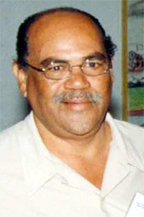Guyana’s gold mining sector approaches the end of its second quarter of 2010 confident of its capacity to surpass its overall 2009 production yield of 311,000 ounces, but decidedly wary about its long-term future. Not that the industry has any doubts about its capacity to do even better in 2010.

Both Frederick Mc Wilfred, the newly elected President of the Guyana Gold and Diamond Miners Association (GGDMA) and Edward Shields, the association’s Executive Director are upbeat about the prospects that gold can continue to be the shining star of the Guyana economy. The industry’s success has attracted the attention of the wider business community and Shields said that local entrepreneurs who, hitherto, had nothing to do with the gold mining industry and others who had more-or-less “retired” from mining are mulling millions of dollars of investment in the sector, while there is money to be made by importers of mining equipment. Some commercial banks too, appear to be softening their traditional reluctance to lend to the sector. “In terms of what gold has done and can continue to do for the economy there is a great deal of optimism,” Shields said.
All, however, does not glitter in the gold industry. High yield and rising world market prices have coincided with new challenges most of which are linked to an increasingly energetic environmental lobby that has taken aim at gold mining. Setting aside the impending ban on the export of mercury by both Europe and North America, the world’s leading producers of the commodity, the industry is caught firmly in what appears to be a more boisterous official insistence that it confirms to regulations that have to do mostly with environmentally responsible mining.
Neither Shields nor Mc Wilfred is keen to create the impression that government and the mining sector may be on a collision course but the indications that the relationship is far from good are clear. Miners are holding their proverbial breath while awaiting official pronouncement on the recommendations of a Special Land Use Committee (SLUC) comprising state and sector representatives and set up earlier this year in the wake of a major protest by miners at Bartica over an attempt by government to impose tough new regulations that require miners to provide as much as six months notice of their intention to work a mining claim. The aim of the SLUC is to fashion proposals for responsible mining which government will have to veto and it is no secret that differences have arisen between the miners’ representatives and government’s representatives on the committee headed by Transport and Hydraulics Minister Robeson Benn over what is likely to be acceptable to the miners. Both Shields and Mc Wilfred believe that the eventual outcome of the work of the SLUC will be a watershed for the industry.

If neither of the two GGDMA officials believe that further confrontation is imminent, neither is wildly optimistic that the result of the SLUC’s work will bring an end to the uneasiness in the sector. Shields said that “a great deal is on hold including possible investments by businessmen who are waiting to see what the official position will be,” adding, “whatever happens the industry will survive.”
The GGDMA officials accept that the authorities are under some pressure to clean up the environmental indiscretions of an industry which they concede is not beyond reproach. Shields said he wanted to “be clear” on the obligation of the mining industry to “clean up its act” and to take a more responsible view of the environment. “Frankly, I believe that we have to face the implications of mining for the environment and to adopt an attitude to mining regulations that reflects an awareness and a sense of responsibility. We have had a lengthy grace period. Of that there is no doubt.”
He made the point, however, that given the relatively small area of the country where mining is concentrated, the issue of environmental degradation is blown out of proportion. The real problem, he said, had to do both with the limited capacity of the GGMC to properly police the mining sector and what he believed are prejudices that are applied in the enforcement process. Miners have complained that corrupt practices including “shakedowns” have become par for the course in the policing process. And in an industry where down time resulting from cease work orders issued by mines officers can cost miners millions of dollars, many of them reportedly pay up without murmur.
Officially too there is money to be made by the GGMC from the sector apart from the royalties which the commission rakes in; mining claim auctions continue to be a considerable source of revenue. Less than a month ago the commission’s May 25 auction netted around $150 million in a single day.
Given President Jagdeo’s Low Carbon Development Strategy (LCDS) Shields and Mc Wilfred do not challenge the view that the renewed sense of urgency which the GGMC appears to be attaching to the enforcement of mining regulations is driven as much by the desire to do the politically correct thing as the need to clean up the sector. There is, what is believed in some quarters to be a sense of wholly misplaced urgency about mining. And this is perhaps reflected in what Shields said have been attempts by some mines officers to enforce regulations that are yet to be agreed to between the authorities and the miners. It works in some cases because, as Shields puts it, “however stringently you follow the regulations it is perhaps always possible for you to be cited on some infringement.”
The GGDMA appears to have taken a position of cautiously downplaying the prospects of yet another major falling out between government and the miners though both Shields and Mc Wilfred admit that the miners are prepared to do “what is necessary within the parameters of the law to protect their livelihoods.”
Mc Wilfred, who resides in Bartica and who was one of the key movers behind the protest appears to have assumed a posture of measured militancy. When you ask him about the mood of the miners he quietly responds that having worked so hard for what they have “the miners will not allow the industry to be destroyed.”
Some miners, however, have begun to send clear messages that the GGDMA’s relatively moderate position has to be ramped up ahead of any official pronouncement on the SLUC. Veteran miner and executive member of the GGDMA Patrick Perreira has used lengthy newspaper advertisements to publicize what he calls “the planned complete shutdown of all mining and logging operations.” In his most recent advertisement Perreira made clear the preparedness of miners to “oppose any proposal that is unacceptable to them,” a clear hint at a militant response to outcomes from recommendations flowing from the SLUC that are perceived as harmful to miners’ interests.
Shields believes that the GGDMA has grown stronger despite what he said have been “attempts to dismantle and divide us”. He said efforts have been made to persuade small scale miners that the association is concerned only with the interests of the bigger players in the industry. Eighty per cent of the gold declared by the industry last year was mined by the country’s top 200 miners and of the top 25 miners in the industry 21 are members of the GGDMA. He made no secret of the fact that the association possesses a powerful potential lobby in an industry that is probably at the peak of its power though he insisted that its work seeks to ensure the survival and growth of the industry “as a whole”.
One senses a muted resentment over what the association said has been the failure of mainstream business organisations like the Private Sector Commission (PSC) to voice any public support for the miners though neither Shields nor Mc Wilfred rules out the likelihood that a point may be reached when some kind of affiliation will be sought. For the time being, however, the GDMA seems prepared to tough it out and while both Shields and Mc Wilfred regard the association as a mechanism for negotiating the interests of the mining industry they point to the Bartica protest as an indication that the miners themselves remain cognisant of the need to protect interests which, in some cases, have been secured through struggle which, as Shields put it, “cannot be understood by people who have not had the experience”.





